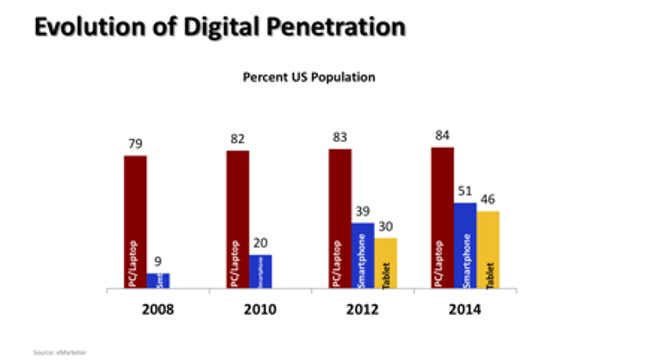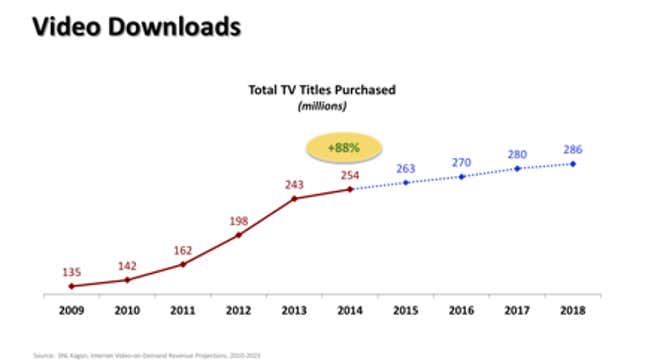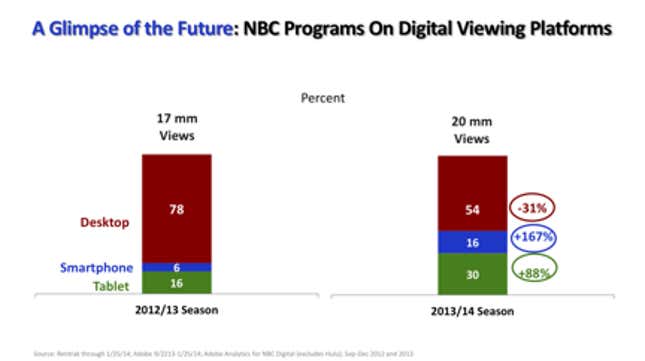Earlier this month, research gurus from CBS, Fox, FX ,and Showtime shared data that show that Americans are watching more TV than ever, but doing so on their own timetables. The effect of this is that audiences for many shows double in the 30-day period after an episode’s initial premiere.
In a separate briefing with reporters this month at the Television Critics Association’s summer press tour, Alan Wurtzel, NBC’s head of research and media development, also explained how audiences are using their smartphones, tablets, and most of all—though perhaps not for much longer—personal computers and laptops to watch and download TV content.
This isn’t just about “a bunch of 25-year-olds who wear black and live in Williamsburg. It affects everybody across the country,” said Wurtzel, who shared NBCUniversal’s data with Quartz. “One size no longer fits all.”

Currently, 84% of the US population has access to a PC or laptop, a number that has remained “pretty consistent” since 2008, said Wurtzel. But the smartphone “hardly existed in 2008. Today, half the population has it. And that’s definitely going to grow by the end of the year.” The increase has been more pronounced with tablets, which “didn’t even exist” in 2010 when Wurtzel’s team did research for the Winter Olympics in Vancouver. “Now it’s close to half. I think by the end of the year, tablets will reach closer to 60%.”


US audiences spent an average of just 2.2 hours per month streaming video in 2008, but that figure has jumped to 8 hours in 2013, an increase of 264% over that time. But, Wurtzel points out, 2012-2013 was especially interesting–a 45% increase in just one year.
While people spent equal amounts of time in 2010 streaming TV shows and “user-generated” content (like home videos and much of what you find on YouTube)—an average of one hour, 30 minutes per month—the balance has shifted dramatically in favor of TV as of late, while user-generated content viewing dropped a full hour from 2012 to 2013. “I think they’ve seen enough of the cat basically chasing its tail,” said Wurtzel. “As older viewers become streamers, they’re less interested in user-generated content, much more interested in the kind of premium content that we provide.”

Meanwhile, downloads of TV episodes (which includes episodes purchased—not streamed—via iTunes, etc.) have increased 88% since 2009. “What we’re seeing there now is it’s a quarter of a billion downloads,” said Wurtzel. “I know that the music industry is finding that downloads are going away, to be replaced by streaming. There’s a lot of streaming going on, but there’s also an awful lot of downloading.” And even as projections flatten out, “you’re coming close to almost 300 million downloads of TV content. That’s hardly shabby.”

Each year, more consumers with smartphones and tablets are using them to view TV and films. Out of smartphone users age 18-64, 20% of them watched a TV show or movie on them within the past seven days, and 54% of households with tablets have used them to watch a TV program or movie, up from 48% just one year ago. “And it’s estimated that, by 2015, tablets are going to outsell desktops and laptops,” said Wurtzel. “They are a lot of what our future will be.”
Wurtzel shared another revelation that he admitted seems “counterintuitive: most mobile consumption doesn’t occur outside, it occurs in the home.” Sixty-one percent of content viewed on a mobile device is done so from inside the home; 39% out of the home. And of that in-home content, 49% of it is consumed in the bedroom. “By the way, [much of it] is consumed around a little after 10:30,” said Wurtzel. “As mobile and portability increases, even though only a third of the use is out of the home, that third of the use is going to grow.”
While Nielsen will finally incorporate mobile viewing into its TV ratings beginning this fall, they will still be ignoring a large portion of the audience that streams TV shows. “Here’s the thing: the biggest amount of streaming that takes place, 50% of it right now, is viewed on a computer, a PC or a lap,” says Wurtzel. “That’s not going to be measured next September. So they’re missing 50% of the action right away.”
That number, however, is rapidly shifting in favor of tablet and mobile viewing, as Wurtzel showed when he crunched the numbers for streams of NBC programs on NBC.com in 2012 (17 million total views) and 2013 (20 million).

“This year the consumption of digital views on a tablet doubled to 30%. The smartphone tripled, and the desktop declined by 31%,” said Wurtzel.
And as viewers stream in greater numbers, especially on their mobile devices, these seismic shifts will only continue. “These changes are very real,” said Wurtzel. “They’re growing unbelievably fast, and they affect the core of our business.”